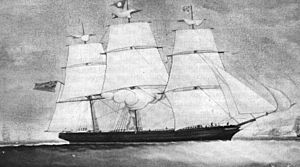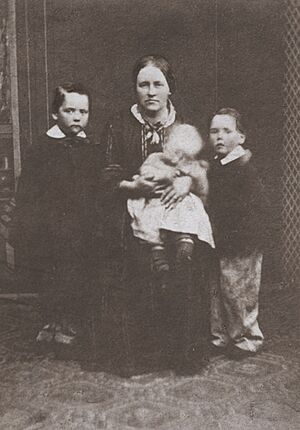Mimosa (ship) facts for kids
 |
|
Quick facts for kids History |
|
|---|---|
| Name | Mimosa |
| Owner | Robert Vining, William Killey, Liverpool; Daniel Green |
| Builder | Alexander Hall and Sons, Aberdeen |
| Cost | £5,916 |
| Launched | 21 June 1853 |
| Fate | Hulked; lost at New Calabar. |
| General characteristics | |
| Tons burthen | 447 tons NM, 540 tons OM |
| Length | 139.9 ft (42.6 m) |
| Beam | 25.5 ft (7.8 m) |
| Depth of hold | 15.6 ft (4.8 m) |
| Sail plan | Ship rigged, 3 masts |
The Mimosa was a famous clipper ship. It is best known for carrying the first Welsh families who moved to Argentina, South America in 1865. These brave settlers wanted to start a new life and keep their Welsh language and traditions alive.
The Mimosa's Journey to Patagonia
The Mimosa was built in 1853 in Aberdeen, Scotland. It was a working ship for many years. Before its famous journey, it was changed to carry passengers. This was a big task, costing about £2,500. Each adult passenger paid £12, and children paid £6.
On May 28, 1865, the Mimosa left Liverpool, England. Aboard were about 153 Welsh passengers. Captain George Pepperell led the ship with his crew of 18. Dr. Thomas Greene, from Ireland, was the ship's doctor. Their destination was Argentina in South America.
After a long journey, they landed on July 28, 1865. They named their new home Porth Madryn. Two men, Edwyn Cynrig Roberts and Lewis Jones, had arrived earlier. They helped prepare for the settlers' arrival. The main goal was to create a Welsh colony. This colony would help keep the Welsh language and culture alive.
The chosen spot for the colony was the Chubut River valley. On September 15, 1865, they named their first town Rawson. It was named after Guillermo Rawson, an Argentine minister. He supported the Welsh settlers. Later, the settlers built other towns like Gaiman and Trelew.
The Legacy of the Mimosa Settlers
It's hard to know the exact number of people who sailed on the Mimosa. Many early records were lost in a big flood in 1899. However, the Welsh colony grew. In 1875, the Argentine government gave land to the settlers. This encouraged many more Welsh people to move there.
Today, the Welsh colony is known as Y Wladfa. It is still active in towns like Gaiman, Trelew, and Trevelin. About 50,000 people in Argentina have Welsh ancestors. Around 5,000 of them still speak the Welsh language. This shows how important the Mimosa's journey was.
See also


